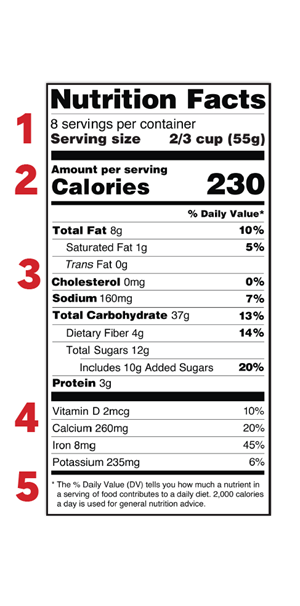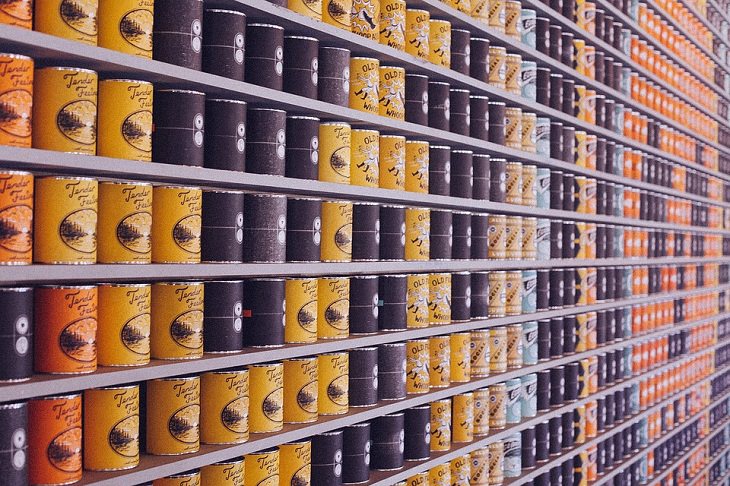38 how to understand calories on food labels
How to read nutrition labels - Calories in food and drinks How to read a nutrition label. Every packaged food that you pick up has to provide you with certain information by law. This information relates to the ingredients and nutritional value of the food, and can be found by reading the nutrition facts label, which is always clearly highlighted on the exterior of the packaging. However, understanding ... This Is How to Read a Nutrition Facts Label on the Keto Diet You don't have to memorize these values, but simply keep in mind that calories are the sum total energy of the protein, carbs, and fats found in food, and they strongly influence whether you lose, maintain, or gain weight. Percent Daily Value (% Daily Value)
3 Ways to Read Nutrition Facts on Food Labels - wikiHow Empty calories refer to calories that are low in nutritional value, like pizza, soda, or sausage. 2 Read the fat content in a serving and check what types of fat are present. The next row on the label is fat, and it is accompanied by 2 different types of fat underneath the total number content.
How to understand calories on food labels
PDF How Do I Understand the "Nutrition Facts" Label? your total calories. For a person who needs 2,000 calories a day, this is 120 calories or less, or about 13 grams of saturated fat. Most foods in the grocery store have a Nutrition Facts label and ingredient list. When you go grocery shopping, take time to read the Nutrition Facts labels on the foods you purchase. Compare the nutrients and How to Read Carbohydrates on Food Labels - GlycoLeap That would be around 15 to 30 g of carbohydrates. Snack = 15 - 30 g of carbohydrate. For the main meals (breakfast, lunch, dinner), 2 to 3 servings of carbs would be enough. That is about 30-45 g of carbohydrates. 3 servings of carbohydrates are about the size of 1 fist size of rice. How to Read Food Labels- Performance Triad To know exactly how much you are eating, weigh or measure your food. The next section lists nutrients. The % Daily Value is based on a 2,000 calorie diet. But a quick rule of thumb is that 5% is low and 20% is high. Information is provided on saturated fat, trans-fat, and cholesterol because you want to minimize your intake of those items.
How to understand calories on food labels. How to Understand and Use the Nutrition Facts Label | FDA That is two times the calories and nutrients shown in the sample label, so you would need to double the nutrient and calorie amounts, as well as the %DVs, to see what you are getting in two... How To Read Food and Beverage Labels | National Institute on Aging Or you can call the U.S. Department of Agriculture's Food and Nutrition Information Center at 301-504-5414. Understanding percent Daily Value (% DV) The percent Daily Value (% DV) tells how much a nutrient in a serving of the food or beverage contributes to a total daily 2,000-calorie diet. Calories on the New Nutrition Facts Label | FDA One package of food may contain more than one serving, so, if you eat two servings you would be getting two times the calories shown on the label. For example, if you ate one serving of the food ... How to Read a Nutrition Label - WebMD If you eat the whole can, multiply these amounts by 2.5 for a total of 150 calories and 12.5 fat grams. Nutrients by Weight and Percentage of Daily Value (%DV) If you're counting fat or...
How to Read the Nutrition Facts Label on Packaged Foods Sodium. Many people get far too much salt, or sodium. Most of it is in packaged foods and restaurant items. Limit salt to 2,300 milligrams (about 1 teaspoon) daily. If you have high blood pressure ... Food Labels 101: Understanding the Nutrition Facts Label Nutrition labels are based on a daily 2,000 calorie diet. Depending on your age, gender and activity level, you may need to consume more or less than 2,000 calories per day, so keep this in mind when viewing each label. Now let's take a look at the parts of the nutrition facts label and break it all down. Anatomy of a Nutrition Facts Label Understanding Food Labels — Tsirona Understand the Nutrition Label. Nutrition labels contain critical health information, but the many numbers might be confusing. The first bit of information is usually the number of calories per serving. Other numbers include carbohydrates (categorized into fiber, total sugars, and added sugars), protein, and fats. These are the three main ... How To Read Food Labels: Understanding the Basics - Instacart The nutrition facts table is usually found on the rear or the side of the label. This is perhaps the most useful part of a food label, providing a detailed breakdown of the product's nutritional content, including calories, protein, carbohydrates, fat, and more. 1. Beware of misleading claims.
How to Read a Nutrition Label: The Path to More Empowered Eating Choices To figure this out, multiply the number of servings you consumed (or plan to consume) by the calories and grams of fat, sodium, sugar, and carbohydrates provided on the food label. Practice Using the product you have and what you typically consume, calculate how many calories, fats, sodium, sugars, and carbohydrates your serving yields. How Do They Calculate Calories on Food Labels? The researchers ignite the food with an electric current, the water absorbs the heat released as the food burns, and a thermometer measures the changes in temperature in the water. Finally, the calories are determined by calculating the change in water temperature multiplied by the volume of water. Calories on food labels Understanding calories - NHS PDF How to Read the Food Label - Risk Services Look at the calories on the label and compare them with the nutrients. Then decide if the food is a good choice for you. Know your fats. Look for foods low in saturated fats, trans fats, and cholesterol to help reduce the risk of heart disease (5% DV or less). There's no DV for trans fat because it's best to limit or avoid it.
How to Read Nutrition Facts Label - Food Network The point is food companies know that 200 calories will look way more appealing to a shopper than 800 calories. Once again, it's companies trying to lure you in. This carries over to all the other...
How to read food labels: MedlinePlus Medical Encyclopedia If you eat 2 cups (0.48 liters) at a meal, you are eating 2 servings. That is 2 times the amount of the calories, fats, and other nutrients listed on the label. Calorie information tells you the number of calories in 1 serving. Adjust the number of calories if you eat smaller or larger portions.
How to Read Nutrition Labels | Cooking Light Reading nutrition labels can be tougher than you'd think, but we are here to help. Learn how to decipher nutrition facts panels to stock up on healthy Reading nutrition facts panels are a great way to help you make informed healthy eating decisions, but they can be tough to decipher. ...
Understanding Food Nutrition Labels - Calorie Control Council Understanding Food Nutrition Labels April 17, 2015. ... some look for the item with the least amount of total fat and others look only at the calories. Many consumers don't understand that all the information included on the label works together and is equally important when making a decision about what you take home with you.
Understanding Food Nutrition Labels | American Heart Association 1 - Start with the serving information at the top. This will tell you the size of a single serving and the total number of servings per container (package). 2 - Next, check total calories per serving and container. Pay attention to the calories per serving and how many calories you're really consuming if you eat the whole package.
How to Read a Dog Food Label - American Kennel Club Quick Tip: Look at the basic four: protein, fat, fiber, and water. Many states have regulations requiring the minimum amount of nutrients a pet food must contain, as well as the maximum amount of ...
How to understand food labels - Eat For Health The Nutrition Information Panel on a food label offers the simplest and easiest way to choose foods with less saturated fat, salt (sodium), added sugars and kilojoules, and more fibre. It can also be used to decide how large one serve of a food group choice or discretionary food would be and whether it's worth the kilojoules.
Interpreting a Nutrition Label | Online Graduate Programs | Baylor You can find out how many of those calories come from fat by referring to the food label section, "Calories from fat." RAW AMOUNT How much of each nutrient is in 1 serving? This is shown in grams (g) or milligrams (mg). In this example, there are 100 mg of sodium in 1 serving. PERCENT DAILY VALUE
Understanding Food Labels | The Nutrition Source | Harvard T.H. Chan ... The label lists the calorie amount for one serving of food. The serving size, also important but often unnoticed, is easily doubled or tripled when not paying attention to the serving size, quickly inflating the calories. Highlighting both of these values emphasizes their importance and relationship.
How to understand food nutrition labels - Medium Calories per serving This number tells you how much energy is contained in one serving of this food. Calories are units of energy. Our bodies burn calories during activity and we gain calories from...
How to Read Food Labels- Performance Triad To know exactly how much you are eating, weigh or measure your food. The next section lists nutrients. The % Daily Value is based on a 2,000 calorie diet. But a quick rule of thumb is that 5% is low and 20% is high. Information is provided on saturated fat, trans-fat, and cholesterol because you want to minimize your intake of those items.
How to Read Carbohydrates on Food Labels - GlycoLeap That would be around 15 to 30 g of carbohydrates. Snack = 15 - 30 g of carbohydrate. For the main meals (breakfast, lunch, dinner), 2 to 3 servings of carbs would be enough. That is about 30-45 g of carbohydrates. 3 servings of carbohydrates are about the size of 1 fist size of rice.
PDF How Do I Understand the "Nutrition Facts" Label? your total calories. For a person who needs 2,000 calories a day, this is 120 calories or less, or about 13 grams of saturated fat. Most foods in the grocery store have a Nutrition Facts label and ingredient list. When you go grocery shopping, take time to read the Nutrition Facts labels on the foods you purchase. Compare the nutrients and













Post a Comment for "38 how to understand calories on food labels"